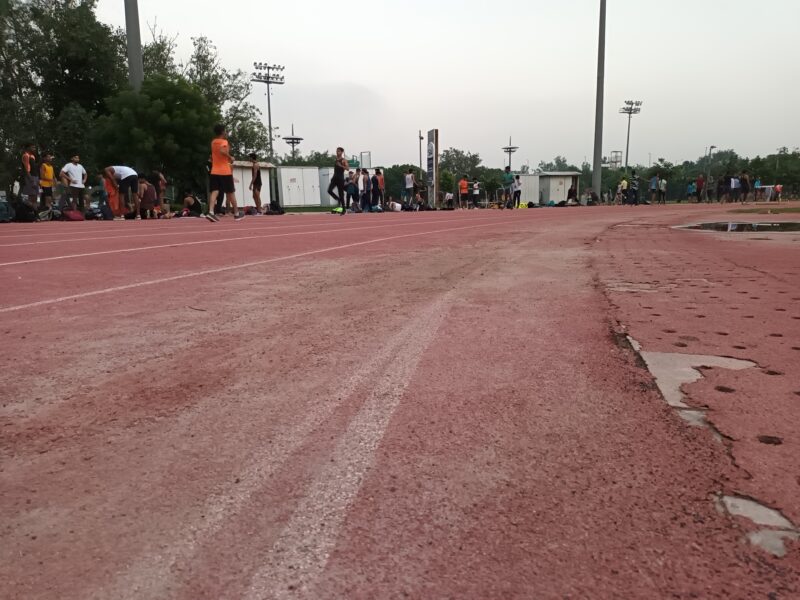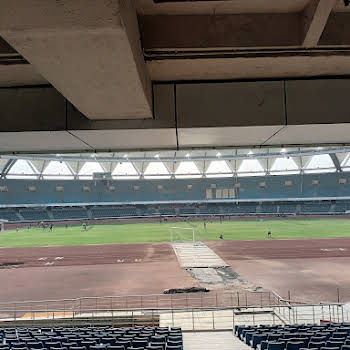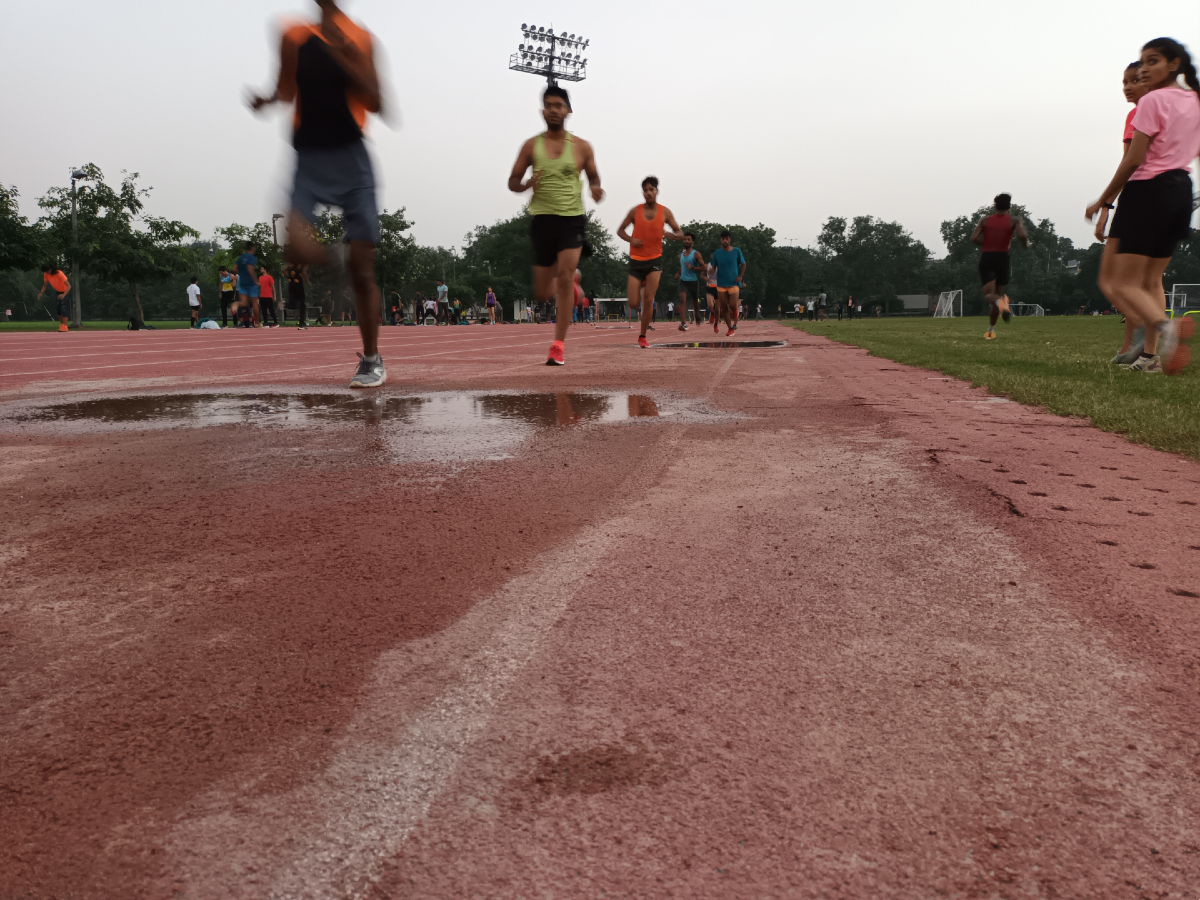The iconic Jawaharlal Nehru Stadium (JNS) in the national capital should ideally showcase facilities for track and field athletes,which can be compared to international standards.
But the synthetic track whichhosted the 2010 Commonwealth Games (CWG) athletics competition has caved in due to faulty civil work on the home stretch(last 80-100m) and back stretch (last 300m) of the eight-lane 400m track.
Even the surface of the eight-lane warmup track, adjoining the main track, used by hundreds of athletes daily has worn out.
The JNS was set up for the 1982 Asian Gamesheld in New Delhi. Since then, the main athletics track has been renovated thrice.
Also read: Scoring goals despite odds
The last major renovation took place in 2008 for the 2010 Delhi Commonwealth Games. In addition to the main track, a warm-up track was also constructed in 2008 for the athletics competition at the 2010 Commonwealth Games.
The life span of a synthetic track is usually 6-7 years.
However, the warm-up track of the JNS is more than 10 years old.
“It is unsuitable for practice and can cause injuries,” said Rupinder Singh, a former distance runner and coach.
“Lack of good facilities at the grassroots only reflect the redtape.”
The JNS is under the jurisdiction of Sports Authority of India (SAI), a technical arm of the Ministry of Youth Affairs and Sports.
SAI had initiated renovation work in 2019 for the main eight-lane track at JNS and sanctioned Rs 6 crore approximately.But the project is still pending as the newly-laid track has become uneven due to faulty base work done in 2008.
In the ongoing renovation work, only the top synthetic layer was placed while the base remained untouched.
The work was allotted to WAPCOS (Water and Power Consultancy Services India Ltd), and was stoppedfor a while in 2020 due to Covid19 pandemic.
The agency allotted the renovation work, it seems, lacked technical inputs and didn’t take themfrom the Athletics Federation of India (AFI).
However, when the work was near completionearly last year, WAPCOS, it is learnt, involved a technical panel of AFI, which pointed to uneven surface on the home and back stretches. During the rainy season in July to September last year, the track became more uneven.
“Now SAI is spending another Rs 50 lakh approximately for research work to find out the root cause of track sinking in certain areas,” a senior athletics coach at the JNS said.
“The work is allotted to IIT, Guwahati. The IIT report is yet to be made public.”
The life-span of synthetic track, as mentioned above, is generally six to seven years and even as two years have lapsed since the renovation work started, the main track of the JNS hasstill not been put to use.
Track jinxed
During the 2010 CWG event, JNS was the venue for the opening and closing ceremonies apart from the track and field competitions.
For the 2010 CWG opening and closing ceremonies, an underground tunnel was constructed that divides the 400m oval into two halves.The tunnel runs from east to west.
Even before athletes could step onto the newly-laid track in 2010 for the CWG event, it was damaged at the 300m mark afteran overloaded truck crossed the track. It had to be hurriedly repaired.
The main part of the track started withering with the passage of time,particularly due to seepage caused by underground tunnel during the raining season.It has left the track uneven.
“Due to faulty base work, the track got damaged halfway through the home stretch and back stretch near the 200m starting point,” ML Dogra, a former official of the AFI explained.
“The tunnel is not in use. It should be closed and filled with concrete and cement to ensure there is no seepage.”
A faulty base is giving top officials of the SAI sleepless nights, another athletics coach said.
“The base work of the track was overlooked during renovation for the 2010 CWG. Since the track got damaged frequently in the past, patch-work was done to level it,” the coach revealed.
In 2020, the sports ministry proposed to remake the JNS sports complex in private partnership — worth Rs 7,000 crore — so that the stadium could host world-class multi-sports events.

However, the project couldn’t take off. The JNS was the venue for the 2017 FIFA U-17 World Cup matches.
After the 2010 CWG, no major international athletics meet was conducted by the AFI. Only domestic meets were conducted,and they too were held on the worn-out warm-up track like the one in 2022.
The 2017 Asian Athletics Championship was organised at Bhubaneswar’s Kalinga Stadium in Odisha and not in Delhi.
Hub of athletics
The JNS is the main attraction for athletics and other sports in Delhi and NCR region since it is centrally located and iswell connected by the bus and metro services.
There are almost 1,500 school and college-going students from Delhi and NCR, including national level athletes, who are registered with the SAI and are regulars at the JNS.
The Nehru stadium is generally open late until evening and athletes can be seen practicing under floodlights.

“Other sports facilities in Delhi — under the state government — that have synthetic track are generally open for Delhi’s school students and that too for limited duration in morning and evening. But JNS is open even after office hours,” a SAI official said.
Since the main track is closed to the public as it is under renovation since 2019, there is pressure on the warm-up track. Overuse of the -up track is quite visible from a distance. The first lane of the warm up track has been damaged to an extent that the synthetic top layer has completely vanished.
“Young athletes practicing on the worn-out track gives an impression that no one is thinking about having good facilities at the grassroots,” Rupinder Singh, a former Delhi-based distance runner said.
“Over 150 to 200 athletes use the JNS track for speed training daily. Primary focus should be grassroots, which is generally ignored for reasons best known to the officials.”
The JNS is next door to SAI headquarters and the administrator of the stadium also has his office within the complex.
“There is no pole vault pitch and steeplechase barrier. During the Delhi State Athletics meet, pole vault and steeplechase events are not conducted.It’s shameful,” said a local coach.
“Nowadays, it’s mandatory to qualify for the national competition. If an athlete doesn’t have a state certificate to prove his or her credentials, the entry for nationalswill be rejected.”
Despite the worn-out track, JNS is home away from home for India’s promising sprinter Rupal Chaudhary of Meerut (Uttar Pradesh). Rupal won individual bronze in women’s 400m and silver in 4x400m relayat the World U-20 held last year in Colombia.
“Since there is no synthetic track in Meerut, we often come to Delhi during competitive season for speed work-out at JNS. The track [in warm-up area] is not good, but it is better than not having the facility,” saidRupal’s coach Vishal Saxena.
The grass field encircled by the main athletics track inside the main complex has been let out to Football Delhi, the Capital’s football governing body.





